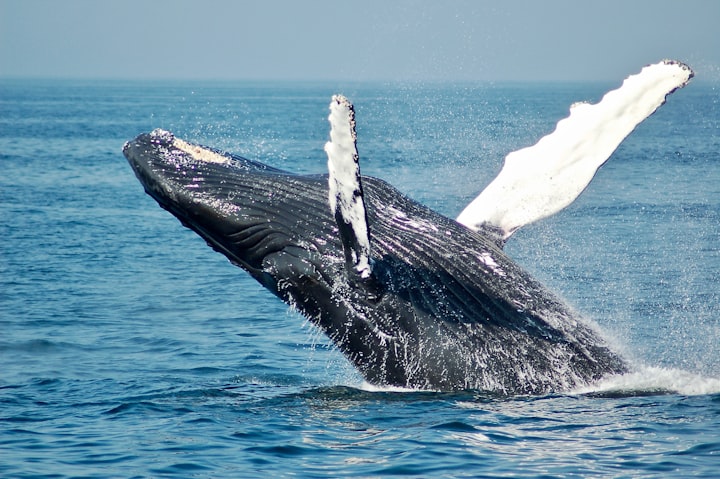Breaking Barriers: The Historic Encounter — Scientists Engage in the First-Ever Conversation with Whales
A Pioneering Journey into the First-Ever Dialogue with Whales and the Future of Interspecies Communication

Late in 2023, scientists made yet another breakthrough that made our modern era seem a smidge more sci-fi. To better understand non-human communication, scientists from UC Davis used playbacks of whale recordings to talk with a female humpback whale named Twain and, amazingly, it worked. Twain echoed back distinct calls and moved about in response to the whale sound recordings. This incredible milestone is already making waves in the scientific community — especially in animal behavior and astrobiology.
--
The study began aboard the Glacier Seal research vessel, drifting quietly with engines off as scientists carefully recorded the haunting song of a pod of humpbacks. After a sighting of the nine whales earlier near Frederick Sound, Alaska, the team had been on their tails for a recording without interference. The effort was a collaboration between the SETI Institute, UC Davis, and the Alaska Whale Foundation, and the partnership already showed success with remarkably clear acoustic recordings. Luck struck for the research team, and they managed to record a crystal clear bit of whale song.
In another incredible stroke of luck, the team had a quick turnaround, traveling only 3 nautical miles (3.45 mi; 5.56 km) away from the original site to find a willing participant the following day, an adult female whale named Twain. For 20 minutes, the scientists aboard the Glacier Seal used an underwater speaker to play their recordings to Twain. Twain, according to the study, echoed back.
Understanding Whale Communication
Whales are ridiculously smart, and have a complex language system to match. As far as we know, whales may have one of the most complex languages within Kingdom Animalia. The sounds they produce, like human speech, have both syntax (word arrangement) and sound units (syllables) that seem to have a particular preferred order to them. As of writing this, however, researchers believe that their songs fall shy of being considered a true language.
Male Humpback Whales Perform This Mysterious Song on Loop 🐋 Great Blue Wild | Smithsonian Channel
We’ve known for quite a while about the intelligence of many whale species. Previous studies have shown an incredible variety of sophisticated behavior in whale species, including tool use, locational abilities, and the creation and maintenance of complex social systems. But their language may perhaps be the most impressive of their sophistications. Depending on the whale species, some populations have entirely different dialects from each other. This means that, despite being the same species, some whales struggle to speak with each other due to their songs’ order or accent. There have even been instances of whales showcasing an incredibly complex culture from pod to pod.
As such, whales have long been considered an excellent species for the study of animal intelligence — if any non-human animal was indeed intelligent enough to communicate with us, whales would certainly make the shortlist.
The First-Ever Conversation
During the entire 20 minutes of communication, the team reported that Twain stayed within 100 meters of the Glacier Seal research vessel. They also noted that no other whales were closer than 200m during the study, making it somewhat more likely that she was indeed responding to the playback, and not some other whale nearby. They also measured both before and after the length of their experiment to make sure that other whale calls weren’t being picked up by their recording software.
The conversation was split into three parts by researchers post-conversation: Engagement, Agitation, and Disengagement. Twain interacted the most at the beginning (the engagement phase) and, as the experiment continued, moved about the boat and echoed calls (the agitation phase) until she seemed to slowly lose interest until she disengaged (the disengagement phase). The scientists recorded her acoustic responses and also took note of her “surface behavior and respiratory activity”. During the beginning portion of the experiment, she approached the boat and moved about, surfacing to breathe. She also echoed back the sounds that the Glacier Seal’s underwater speaker was playing near her, seemingly identifying whale song and attempting to converse with the boat’s speaker.
Reactions and Implications
This study is a huge step towards learning how to communicate with other species, pointing out an incredible method with which we can successfully communicate: high-quality recording and playback. With further testing and development, along with technological advancement, there’s a good chance we’ll be able to one day understand non-human animals the same way we can translate our meaning into different human languages.
Now that we have the technology to converse with whales, all that’s left is to decipher the songs. Some scientists believe that the application of artificial intelligence in this field may be capable of helping us decode animal language. Potentially, using this form of technology to log, sort, and analyze whale song could result in surprisingly quick deciphering. Already, research groups are planning to test implementations — we may very well be close to understanding whale songs.
But above all else, this breakthrough highlights the need to preserve the species on our planet. There’s still so much we don’t know, and the creatures we inhabit earth with may have the answers we seek. Continuing our research of extra-human communication could aid us incredibly, offering insight and perspectives that radically alter our lives. But, to continue taking those steps, we must survive and sustain the species we survive along with.
We won’t be able to decipher whale songs if the whales stop singing.
The Future of Non-human Communication
Moving forward, scientists will need to establish a strict methodology to avoid falsely interpreting signals and non-human speech. We must avoid anthropomorphization (attribution of human personality to non-human creatures) considering how wildly different their brains are from ours. This will be no easy feat, considering our empathy pushes such traits on creatures we interact with. But assuming human-ness is a bias may set us back from truly understanding the diverse minds that comprise life and sentience in this amazing universe.
We also gravely need repeats of this experiment that show similar, or at least comparable success. Though this anecdote with Twain is remarkable, a single study organism cannot support the whole of a scientific theory. We need more data to confirm that the language that we’re broadcasting is truly meaningful to whales, and not just a novelty to curious Twain.
But even with these challenges, there’s much room for optimism in this emerging field of research. The researchers wrote it best, “although considerably challenging, adaptive interactive acoustic playback is possible to conduct given recent innovations in technology.” As I mentioned above, this milestone may be the beginning of understanding between our two species. With further technological advancement and scientific implementation, we may begin to truly understand what communications we’re making with whales shortly.
And, once we decipher the speech of whales, we may be able to apply our newfound dialect-deciphering knowledge to do the same with other animal kingdom dialects, other earth-dwelling species, and, maybe even eventually, extra-terrestrial organisms far out in the universe. The development of this technology the first time around, with whales like Twain has incredible potential for wider application down the line. One day, we may be able to say that Twain helped us speak with alien life.
--
This groundbreaking step in decoding non-human communication holds the potential to reshape our understanding of language beyond our species. While celebrating this achievement, we must not lose sight of the critical need to preserve our oceans and safeguard the species that inhabit them. By making informed choices today, we pave the way for future generations to explore the rich tapestry of communication with other species.
On the verge of communicating with other intelligent beings, the implementation of AI and machine learning offers a promising path forward. As we celebrate the first step in understanding whale communication, the journey must continue. With dedicated conservation efforts, ample funding, and sustained attention, we may unlock the secrets of communicating with extra-human sentience. Thanks to the inquisitive whale, we stand at the cusp of decoding the language of sentient life across the galaxy.
The journey has just begun.
--
Interested in learning more about the study? You can read the published article here:
--
Crossposted from Medium - Follow Me For Weekly Science Education!
About the Creator
Olivia L. Dobbs
Science Enthusiast, Naturalist, Dreamer, Nerd.
I crosspost my Medium articles here :)
You can find my main account on Medium: https://medium.com/@oliviadobbs13
Check out my science! -> bit.ly/DobbsEtAl






Comments (1)
Enjoyed this so much, whales are amazing critters!